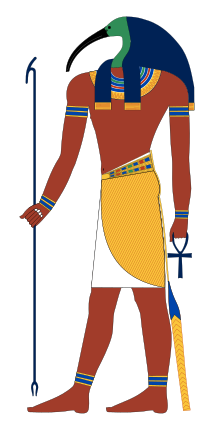| Thoth | |||||||||||
|---|---|---|---|---|---|---|---|---|---|---|---|
 Thoth, in one of his forms as an ibis-headed man | |||||||||||
| Name in hieroglyphs |
| ||||||||||
| Major cult center | Hermopolis | ||||||||||
| Symbol | Ibis, moon disk, papyrus scroll, reed pens, writing palette, stylus, baboon, scales | ||||||||||
| Consort | Ma’at, Seshat, Nehmetawy (In some myths) | ||||||||||
| Offspring | Seshat[a] | ||||||||||
| Equivalents | |||||||||||
| Greek | Hermes | ||||||||||
| Roman | Mercury | ||||||||||
Thoth (from Koinē Greek: Θώθ Thṓth, borrowed from Coptic: Ⲑⲱⲟⲩⲧ Thōout, Egyptian: Ḏḥwtj, the reflex of ḏḥwtj "[he] is like the ibis") is an ancient Egyptian deity. In art, he was often depicted as a man with the head of an ibis or a baboon, animals sacred to him. His feminine counterpart was Seshat, and his wife was Ma'at.[2] He was the god of the Moon, wisdom, knowledge, writing, hieroglyphs, science, magic, art and judgment.
Thoth's chief temple was located in the city of Hermopolis (Ancient Egyptian: ḫmnw /χaˈmaːnaw/, Egyptological pronunciation: "Khemenu", Coptic: Ϣⲙⲟⲩⲛ Shmun). Later known as el-Ashmunein in Egyptian Arabic, the Temple of Thoth was mostly destroyed before the beginning of the Christian era. Its very large pronaos was still standing in 1826, but was demolished and used as fill for the foundation of a sugar factory by the mid-19th century.[3][4]
Thoth played many vital and prominent roles in Egyptian mythology, such as maintaining the universe, and being one of the two deities (the other being Ma'at) who stood on either side of Ra's solar barque.[5] In the later history of ancient Egypt, Thoth became heavily associated with the arbitration of godly disputes,[6] the arts of magic, the system of writing, and the judgment of the dead.[7]
- ^ Hieroglyphs verified, in part, in Budge, The Gods of the Egyptians, Vol. 1, p. 402, and Collier and Manley, p. 161
- ^ Eric H Cline, David O'Connor (January 5, 2006), Thutmose III: A New Biography, University of Michigan Press, p. 127
- ^ Verner, Miroslav (2013). Temple of the World: Sanctuaries, Cults, and Mysteries of Ancient Egypt. American University in Cairo Press. p. 149. ISBN 978-977-416-563-4.
- ^ . Littell's Living Age – via Wikisource.
- ^ Budge, The Gods of the Egyptians, Vol. 1, p. 400
- ^ Budge, The Gods of the Egyptians, Vol. 1, p. 405
- ^ Budge, The Gods of the Egyptians, p. 403
Cite error: There are <ref group=lower-alpha> tags or {{efn}} templates on this page, but the references will not show without a {{reflist|group=lower-alpha}} template or {{notelist}} template (see the help page).